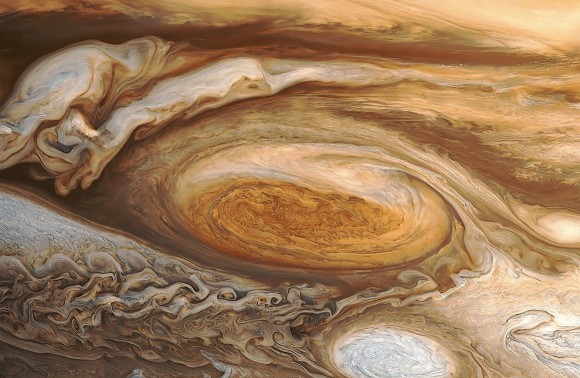NASA Uncovers Why Jupiter's Great Red Spot is Red
| Marco Foronda | | Nov 14, 2014 10:13 PM EST |
(Photo : universetoday.com) Reprocessed view by Bjorn Jonsson of the Great Red Spot taken by Voyager 1 in 1979 reveals an incredible wealth of detail.
Giovanni Cassini discovered the Great Red Spot on Jupiter in 1665. Since then, researchers have been keen to solve the mysteries behind this giant storm, such as why its colored red.
NASA experts used ultraviolet light to simulate sunlight and blasted it at two gases known to exist on Jupiter: ammonia and acetylene. It formed a red material similar to the Great Red Spot.
Like Us on Facebook
The giant red spot is actually a giant storm that has lasted for more than 300 years. It's large enough to fit three Earths inside it and can actually be seen by earthly telescopes.
It rotates counter-clockwise in a six day cycle with a width that's double that of the Earth's.
The Red Spot could be the product of chemicals in the planet's upper atmosphere split apart by the sun.
"Our models suggest most of the Great Red Spot is actually pretty bland in color, beneath the upper cloud layer of reddish material. Under the reddish 'sunburn' the clouds are probably whitish or grayish." said NASA researcher Kevin Baines.
The intensity of the Great Red Spot's color is due to the storm's winds bringing ammonia ice particles into the upper atmosphere of the planet, and then exposing it to more UV light. The storm can't stop the ammonia particles from lingering, creating a constant red color.
NASA says ammonia may "both enable and enhance" the reddening.
"The Great Red Spot is extremely tall. It reaches much higher altitudes than clouds elsewhere on Jupiter," Baines added.
Aside from red, Jupiter showcases colors such as orange, brown and other shades of red.
NASA will present its findings this week at the American Astronomical Society's Division for Planetary Science Meeting in Tucson, Arizona.
TagsJupiter, Red Great Spot, Jupiter's Great Red Spot, NASA, Sunspot, cassini, space exploration
©2015 Chinatopix All rights reserved. Do not reproduce without permission
EDITOR'S PICKS
-

Did the Trump administration just announce plans for a trade war with ‘hostile’ China and Russia?
-

US Senate passes Taiwan travel bill slammed by China
-

As Yan Sihong’s family grieves, here are other Chinese students who went missing abroad. Some have never been found
-

Beijing blasts Western critics who ‘smear China’ with the term sharp power
-

China Envoy Seeks to Defuse Tensions With U.S. as a Trade War Brews
-

Singapore's Deputy PM Provides Bitcoin Vote of Confidence Amid China's Blanket Bans
-

China warns investors over risks in overseas virtual currency trading
-

Chinese government most trustworthy: survey
-

Kashima Antlers On Course For Back-To-Back Titles
MOST POPULAR
LATEST NEWS
Zhou Yongkang: China's Former Security Chief Sentenced to Life in Prison

China's former Chief of the Ministry of Public Security, Zhou Yongkang, has been given a life sentence after he was found guilty of abusing his office, bribery and deliberately ... Full Article
TRENDING STORY

China Pork Prices Expected to Stabilize As The Supplies Recover

Elephone P9000 Smartphone is now on Sale on Amazon India

There's a Big Chance Cliffhangers Won't Still Be Resolved When Grey's Anatomy Season 13 Returns

Supreme Court Ruled on Samsung vs Apple Dispute for Patent Infringement

Microsoft Surface Pro 5 Rumors and Release Date: What is the Latest?










